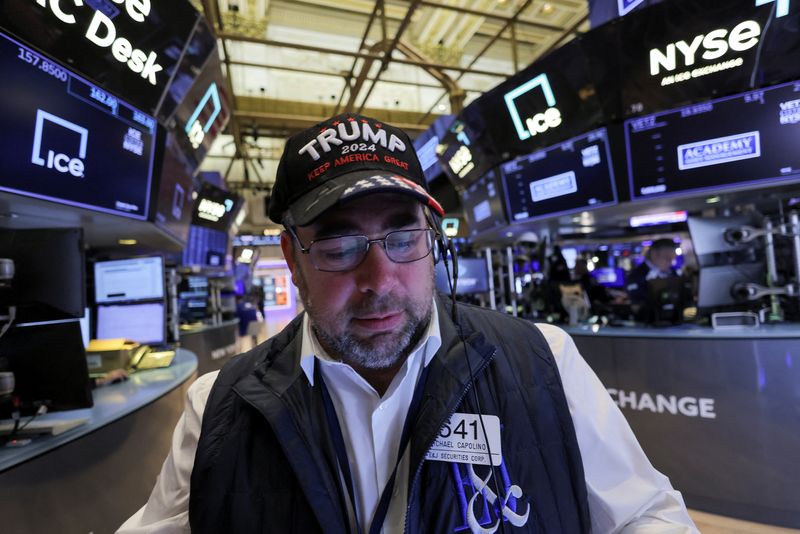
By Chuck Mikolajczak
NEW YORK (Reuters) -U.S. stocks rallied sharply to close at record highs on Wednesday after Republican Donald Trump won the 2024 U.S. presidential election in a stunning comeback four years after being voted out of the White House.
The Dow Industrials, S&P 500 and Nasdaq Composite each ended at record levels with investors expecting lower taxes, deregulation and a U.S. president who is not shy to weigh in on everything from the stock market to the dollar, although fresh tariffs could bring challenges in the form of a higher deficit and inflation.
The Republican’s win powered a rally in so-called “Trump trades,” sending U.S. Treasury yields sharply higher, with the benchmark 10-year note yield hitting a four-month high of 4.479%. Bitcoin hit a record high of over $76,000 and the dollar was on track for its biggest one-day percentage gain since September 2022.
Polls indicated a very tight race, with some concern the process could be drawn out before a victor was declared.
“Investors were kind of portfolio jockeying to score up some of their risk exposure in anticipation of an outcome that was going into it, seemingly a toss-up,” said Mark Luschini, chief investment strategist at Janney Montgomery Scott in Philadelphia.
“And obviously, it turned very quickly and led to a very much risk-on day today in which anything that isn’t tied to the ground from a cyclical or pro-growth standpoint is absolutely launching.”
The Dow Jones Industrial Average rose 1,508.05 points, or 3.57%, to 43,729.93, the S&P 500 gained 146.28 points, or 2.53%, to 5,929.04 and the Nasdaq Composite gained 544.29 points, or 2.95%, to 18,983.47.
Both the Dow and S&P 500 registered their biggest one-day percentage gains since November 2022. The Nasdaq notched its biggest daily percentage gain since February.
Financials jumped 6.16% as the best performing of the 11 major S&P 500 sectors. Banks, expected to benefit from loosening regulations under Trump, powered the gains, with the S&P 500 bank index up 10.68%, its biggest daily jump in two years.
The small-cap Russell 2000 rallied 5.84%, its biggest surge since November 2022, to a three-year high, with the domestically concentrated stocks seen as likely to benefit from easier regulations, lower taxes and less exposure to import tariffs. However, rising Treasury yields could hurt smaller companies, which tend to rely heavily on borrowing and are more sensitive to higher interest rates.
“This move up in interest rates … if it doesn’t stall out here somewhere around this 4.4%, 4.5% level or so, and we start to retest those levels we saw last October of 5%, that could not only put small caps, but the market itself on its heels,” said Luschini.


